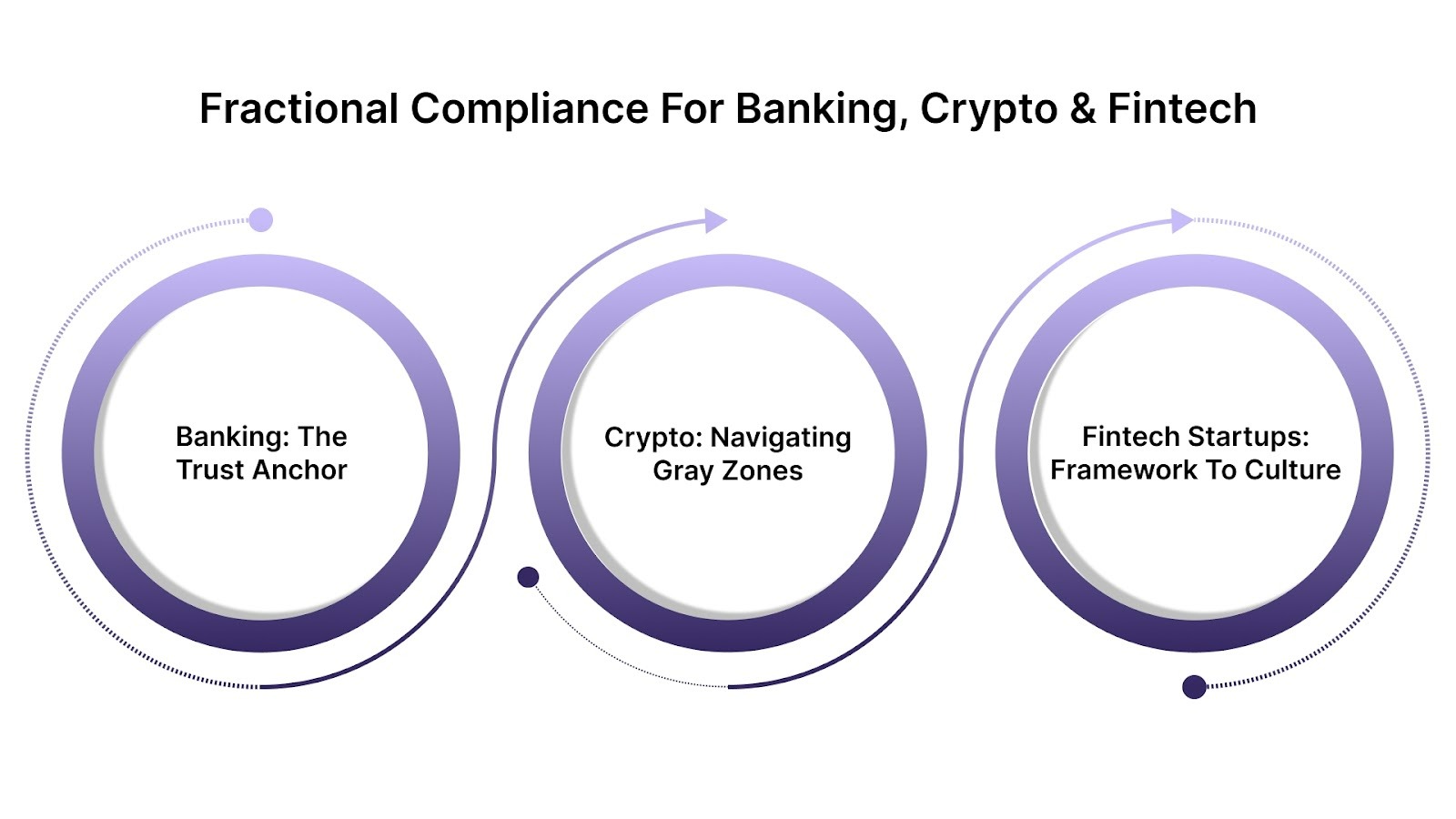Nov 13, 2025
Fractional CMO for Startup Compliance Challenges

By Fraxtional LLC

At some point in your fintech journey, “AML” stops being an acronym you skim past and starts becoming a problem you have to solve. Maybe it’s a sponsor bank asking for your compliance framework, or an investor wanting to see your risk policies before signing the next round. Either way, the question is the same: can your company be trusted with money?
That’s the moment it gets real.
You can’t just move fast and break things when regulators are watching. But hiring a full-time Chief Anti-Money Laundering Officer? That’s expensive, and probably premature.
Still, you need structure, someone who can speak regulator, build your risk matrix, and make sure you don’t trip an AML wire you didn’t even know existed. That’s where fractional CAMLOs come in.
They’re the ones who step in quietly, when you’ve reached the point where good intentions aren’t enough, but headcount still matters. They build the AML framework that fits your business, your risk, and your reality.
Key Takeaways
- A fractional CAMLO (Chief Anti-Money Laundering Officer) delivers on-demand compliance leadership to fintechs and startups.
- They design risk frameworks, AML programs, and governance systems tailored to your stage of growth.
- Ideal for fintechs balancing rapid expansion with tightening regulatory expectations.
- Flexible, cost-efficient engagement models make compliance leadership scalable.
- Fraxtional empowers fintechs with fractional CAMLO and CCO services that grow with their business.
Why Fintech Startups Are Turning to Fractional CAMLO Leadership

The compliance landscape has changed faster than most startups expected. A few years ago, having basic KYC checks and a one-page AML policy was enough to get a pilot off the ground. Not anymore.
In 2025, regulators and sponsor banks are treating fintechs the same way they treat banks, with zero tolerance for weak oversight.
FinCEN has expanded its expectations for fintech AML programs, the OCC continues to pressure sponsor banks to vet their partners more closely, and investor due diligence now routinely includes questions about governance and audit readiness.
That’s a problem for growing startups. The traditional route of hiring a full-time Chief Compliance or Anti-Money Laundering Officer is expensive, slow, and often premature. The average CAMLO or CCO hire in the U.S. costs north of $250,000 annually, not including systems, audit prep, and training. Most early-stage fintechs simply don’t need that level of overhead yet.
But what they do need is credibility. Someone who can design a risk framework, align policies with licensing requirements, and reassure banks and investors that the company takes compliance seriously.
That’s why the fractional CAMLO model has gained so much traction. It gives you enterprise-level compliance leadership on flexible terms, embedding a senior expert for the exact stage and scope you need. For many Series A and B fintechs, that means the difference between a deal closing or stalling.
Beyond cost, the shift is about adaptability.
Fractional leaders bring experience from multiple fintechs, giving them a wider lens on emerging regulatory patterns from money transmission to crypto custody to cross-border remittance. They can stand up governance models quickly, then scale them as you expand into new markets or product lines.
The result?
A compliance function that grows with your business instead of weighing it down.
Let's look at what that looks like in practice.
What Does a Fractional CAMLO Do for Compliance?

You can think of a fractional CAMLO as your startup’s regulatory architect, someone who builds the foundation you’ll need to stand up to banks, investors, and regulators later on.
They’re not here to bury you in policies or slow down innovation. They’re here to make sure your growth doesn’t get tripped up by something as basic as missing documentation or a weak AML audit trail.
Here’s what that actually looks like in practice.
Designing the Risk and Compliance Framework
Every fintech has a unique risk DNA. A fractional CAMLO starts by mapping your products, customer base, transaction types, and jurisdictions to identify where financial crime or compliance failures could occur.
From there, they build a fit-for-stage risk and compliance framework. That includes:
- Risk identification and classification: Defining customer, geographic, and transactional risk tiers.
- Control design: Establishing clear KYC, transaction monitoring, and reporting procedures.
- Monitoring systems: Ensuring AML and fraud detection tools actually match your business model, not just generic vendor promises.
- Escalation and remediation: Setting up clear accountability pathways for suspicious activity or breaches.
This isn’t copy-paste compliance, it’s proportional design. A good fractional CAMLO knows that a Series A payments startup doesn’t need the same framework as a cross-border crypto platform.
By tailoring the system to your size and complexity, they help you stay compliant without crushing agility, and that’s exactly what regulators expect to see today.
Governance and Oversight Under a Fractional Model
Governance is what separates a compliant startup from a credible one. A fractional CAMLO builds that bridge without needing to sit in your office full-time.
They create oversight structures that regulators and sponsor banks recognize:
- Regular compliance committee meetings (virtual or hybrid).
- Board-level reporting dashboards that track AML and risk metrics.
- Independent reviews to ensure internal controls actually work.
- Training programs so your team isn’t just following rules, but understanding why they exist.
The key is independence. A fractional CAMLO isn’t embedded in your hierarchy; they’re positioned as an objective voice who reports to leadership and can speak directly to external stakeholders when needed.
That independence is precisely what gives banks confidence and regulators comfort.
Why It Works
The power of the fractional model lies in precision, along with expertise. A fractional CAMLO knows which risks matter right now, which can wait, and which will keep your investors awake if left unchecked.
They’ve seen the audits, they’ve written the reports, and they’ve lived through the regulator calls. That perspective is what turns compliance from a bottleneck into a competitive advantage.
So far, we’ve looked at what fractional CAMLOs do: designing frameworks, embedding governance, and bringing structure where it matters most.
But how should you actually engage one?
Let’s explore the models fintechs use, from short-term advisory to long-term partnership, and how to choose the right fit for your stage.
How Should You Engage a CAMLO Fractional or Full-Time?

Every growing fintech eventually hits the same crossroad: compliance starts to demand more time than anyone planned for.
There are audits to prep for, sponsor banks to reassure, and suddenly “part-time help” starts looking like a full-time function.
The question here becomes what kind of leadership fits your stage.
When a Fractional CAMLO Is the Right Fit
If you’re building your first product or just starting to move money, you probably don’t need a full internal compliance team. What you need is coverage that counts. Someone who can spot the blind spots before your regulator or banking partner does.
A fractional CAMLO brings that balance. They build your AML and KYC processes, test your monitoring systems, and make sure your policies can hold up to scrutiny, all without adding a permanent executive line item to payroll.
This model works especially well when you’re:
- Establishing your first sponsor bank or PSP relationship.
- Preparing for licensing (money transmission, crypto registration, etc.).
- Answering investor due diligence questions around governance or AML controls.
- Tightening risk practices ahead of scaling into new jurisdictions.
Most fractional engagements last a few hours a week or a few days a month, enough to set up a functioning compliance framework and guide your team through the first round of regulatory expectations.
You get the expertise you’d expect from a global bank, applied with the pace and pragmatism of a startup.
When You’ve Outgrown the Fractional Model
At a certain point, compliance becomes a daily conversation rather than a weekly standing meeting.
That’s when fractional support starts to stretch thin.
You’ve reached this stage if you’re:
- Managing higher transaction volumes across multiple regions,
- Dealing directly with regulators or licensing bodies,
- Running audits or responding to enforcement requests,
- Integrating AML oversight into product and engineering decisions.
When that happens, it’s time to bring a full-time CAMLO into the picture. Someone who can live inside the business, lead a team, and represent your compliance posture externally.
Fractional leaders often help make that transition, recruiting, training, and handing over a program that’s already solid. That continuity is what keeps you from losing ground when compliance scales from oversight to ownership.
A Practical View on Cost and Scale
When your biggest risk is overbuilding before you’re ready, Fractional is the smarter option.
And the moment you prove compliance is part of the product, not just protection, it's time to go full-time.
The way compliance leadership works in fintech depends heavily on the world you’re in.
A sponsor bank has different expectations than a crypto exchange, and a startup in licensing mode faces very different pressure than one already in-market.
Fractional CAMLOs shape their approach across banking, crypto, and fintech startups, three environments where the same role takes on a completely different meaning.
Fractional Compliance Across Sectors: Banking, Crypto, and Fintech Startups

The fractional CAMLO model flexes depending on the regulatory terrain. A community bank’s expectations look nothing like those of a crypto exchange.
Here’s how the role changes shape across the industries driving this shift.
1. Banking: The Anchor for Trust
Banks hire CAMLOs to protect relationships. When you’re a fintech plugged into a sponsor bank, their risk becomes your risk.
A fractional AML officer in banking works as a bridge: translating bank-level oversight into startup-friendly systems.
They audit transaction flows, tighten onboarding checks, and help your team understand what “bank-grade compliance” means.
Most importantly, they maintain credibility with your banking partners.
Sponsor banks are under growing scrutiny from the OCC and FDIC to prove they’re monitoring fintech partners effectively.
Having a fractional CAMLO who speaks their language and knows what their examiners are looking for can make the difference between keeping a relationship and losing one.
2. Crypto: Navigating Gray Zones
Crypto compliance is its own beast, fast-moving, fragmented, and under global watch.
Here, a fractional CAMLO is interpreting rules that sometimes don’t even exist yet.
In this space, fractional leaders focus on:
- Translating evolving FinCEN and FATF guidance into real-world workflows.
- Managing the line between innovation and enforcement (especially around custody and cross-border flows).
- Building controls for high-risk areas like privacy coins, wallets, and DeFi exposure.
- Coordinating with legal counsel to ensure policies match how your technology actually works.
A fractional model gives crypto firms the flexibility to evolve their compliance function as regulations catch up without overcommitting before frameworks stabilize.
Here, they’re translators, converting complex, shifting regulatory expectations into language that engineers and founders can act on.
3. Fintech Startups: From Framework to Culture
In a young fintech, “compliance” usually starts as a shared Google Drive folder and a few spreadsheets no one wants to break.
Everyone’s wearing three hats, and the same person managing growth experiments is probably also signing off on KYC checks.
That works, until it doesn’t.
As soon as money starts moving or investors start asking tougher questions, those patchwork controls begin to show their cracks.
That’s where a fractional CAMLO steps in.
They help you document what’s already working, fix what’s not, and connect the dots between policy, risk, and execution.
The process usually starts small: tightening onboarding flows, setting up transaction monitoring, building a basic risk register, and making sure reporting lines are clear.
But the real shift happens when compliance becomes part of how the company operates.
In payments, that might mean tuning your screening rules so they catch real red flags instead of false alarms.
In lending, it could mean refining due diligence so fraud doesn’t hide behind growth.
A good fractional CAMLO does more than write policies; they teach your team how to think like a regulated company without losing startup speed.
That’s how compliance becomes a habit, not a hurdle.
Where These Worlds Converge
Across banking, crypto, and fintech, one thing is consistent: Regulators are moving faster, and the line between “startup” and “financial institution” is disappearing.
Fractional CAMLOs exist to help founders bridge that gap, bringing the kind of expertise banks respect and regulators trust, in a model startups can actually afford.
They turn compliance from a cost into a capability.
How Fraxtional Works With Growing Fintechs

When a fintech team reaches out to Fraxtional, it’s usually because something’s changed.
Maybe a sponsor bank asked for a full AML review before signing the next agreement.
Maybe a new market or licensing requirement exposed gaps no one had time to fix.
Or maybe the founder just wants someone who’s done this before, someone who knows what “good” looks like.
Fraxtional’s team steps in quietly. They start by looking at what’s already there, the policies, the controls, the workflows. No assumptions, no theory. Just an honest read of where things stand.
From there, the work gets specific:
- Building a risk framework that fits how your product moves money.
- Creating reporting lines that make regulators and banks comfortable.
- Tightening AML and KYC controls without turning your operations inside out.
- Embedding a fractional CAMLO or CCO who can manage oversight while your team keeps building.
They integrate.
The aim is to build something you can own, a program that stands up to audits and scales when you do.
Most of Fraxtional’s value shows up in the background: a smoother audit, a faster bank approval, fewer late-night scrambles before a due diligence call.
That’s what strong compliance leadership should feel like: invisible until it’s needed.
If your fintech is scaling, entering new markets, or preparing for regulatory review, it’s worth having an experienced compliance leader in the room.
Fraxtional connects you with senior-level CAMLOs, CCOs, and risk experts who’ve done this before, for banks, crypto firms, and high-growth fintechs alike.
You decide the scope, the time, and the pace. They deliver the expertise.
Talk to Fraxtional’s team about building a compliance function that grows with your business.
Conclusion
Every fintech has a moment when the business outpaces the guardrails. Growth moves faster than policy, and the systems that once worked start to strain.
That moment doesn’t have to turn into a scramble.
It’s exactly where a fractional compliance leader earns their place, stepping in with experience, building what’s missing, and leaving behind something that lasts.
Fraxtional exists for that middle ground when you’re too lean for a full-time CCO but too visible to stay improvised.
They help founders build compliance that fits, grows, and stands up to scrutiny without slowing down what makes their companies work.
The strongest fintechs are built on trust.
Fraxtional helps you earn it before you need to defend it.
FAQs
A fractional Chief Anti-Money Laundering Officer helps design and oversee AML and KYC programs, monitor risk exposure, prepare for audits, and ensure compliance with banking and FinCEN standards, all on a flexible, part-time basis.
Usually between seed and Series B. You’ll know it’s time when you start handling regulated funds, seeking sponsor bank partnerships, or preparing for licensing.
They act as an embedded leader collaborating with your operations, legal, and product teams. The goal is to strengthen what’s there, not replace it.
Yes. Most regulators and sponsor banks focus on the quality of the controls, not whether the role is full-time or fractional. What matters is that oversight and reporting lines are clearly defined.
Fraxtional operates more like an extension of your leadership team, providing seasoned executives who build, implement, and oversee compliance programs that match your growth stage, without the cost or lag of a full-time hire.
blogs
Don’t miss these
Let’s Get Started
Ready to Strengthen Your Compliance Program?
Take the next step towards expert compliance solutions. Connect with us today.




